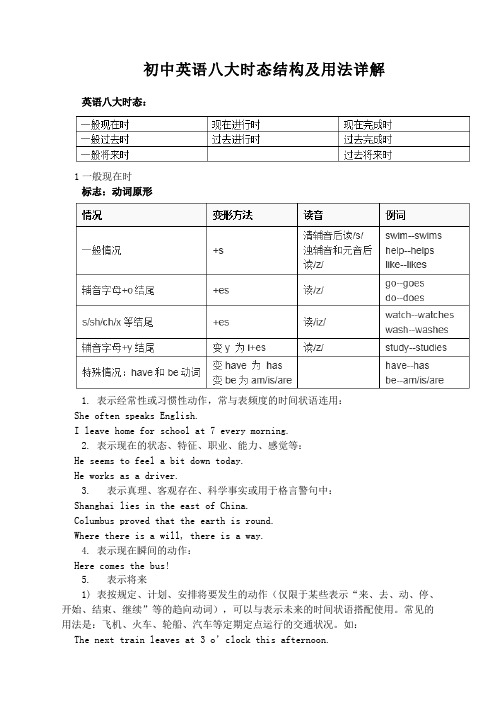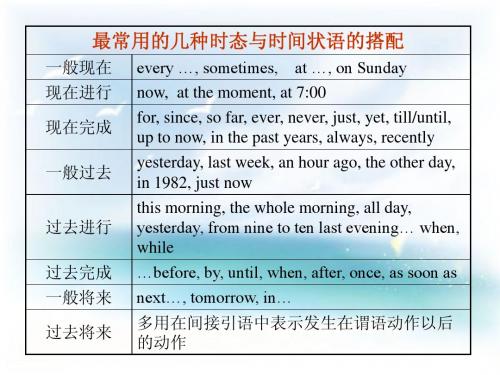最常用的几种时态与时间状语的搭配
- 格式:doc
- 大小:62.00 KB
- 文档页数:5

初中英语八大时态结构及用法详解英语八大时态:1一般现在时标志:动词原形1. 表示经常性或习惯性动作,常与表频度的时间状语连用:She often speaks English.I leave home for school at 7 every morning.2. 表示现在的状态、特征、职业、能力、感觉等:He seems to feel a bit down today.He works as a driver.3. 表示真理、客观存在、科学事实或用于格言警句中:Shanghai lies in the east of China.Columbus proved that the earth is round.Where there is a will, there is a way.4. 表示现在瞬间的动作:Here comes the bus!5. 表示将来1) 表按规定、计划、安排将要发生的动作(仅限于某些表示“来、去、动、停、开始、结束、继续”等的趋向动词),可以与表示未来的时间状语搭配使用。
常见的用法是:飞机、火车、轮船、汽车等定期定点运行的交通状况。
如:The next train leaves at 3 o’clock this afternoon.How often does the shuttle bus run?2) 在时间和条件状语从句中常使用一般现在时表示将来发生的事情:When Bill comes (不用will come), ask him to wait for me.I shall go there tomorrow unless I’m too busy.2一般过去时标志:动词过去式*闭音节:元音字母a, e, i, o, u如果发字母本来的音则称为开音节,否则称为闭音节。
1. 表示过去某时所发生的动作或存在的状态,常与表示过去的时间状语连用(e.g. yesterday, this morning, just now, a moment ago, in May, last night / year / week, once upon a time, the other day, before …, when …, in the past等)。


一般现在时的结构和用法一般现在时的结构和用法1一般现在时的结构和用法一般现在时,是一种英语语法形式。
表示通常性、规律性、习惯性、真理性(即事实)的动作或状态,或者动作有时间规律发生的事件的一种时间状态。
在英语语法中,“时”指动作发生的时间,“态”指动作的样子和状态。
下面店铺向大家介绍一般现在时的'结构和用法,仅供参考!一般现在时的结构一般现在时通常与副词everyday(每天),always(总是),usually(通常),often(经常)sometimes(有时),等时间状语连用。
例:(1)表示事物或人物的特征、状态。
The sky is blue.天空是蓝色的。
Mary's father is an En qlish teacher.玛丽的爸爸是一名英语老师。
(2)表示经常性或习惯性的动作,I get up at six every day.我每天六点起床,She plays sports every day.她每天都做运动。
(3)表示客观现实。
The table has four legs.桌子有四条腿。
There are 50 students in my class.我们班有 50 个学生。
4)表示客观真理,科学原理,自然现象等客观事实或格言谚语等。
The sun rises in the east every day.太阳每天从东方升起。
The earth goes around the sun.地球绕着太阳转。
(5) 表示平日的喜好。
I like bananas. We don't like vegetables.He likes ice cream.She doesn't like strawberries.一般现在时的用法经常性或习惯性的动作,常与表示频腮度的时间状语连用。
(1)时间状语:every.. sometimes, at.. on Sun dayi leave home for school at 7 every morning.(2)客观真理,客观存在,科学事实。

状语从句本质——用不同的连接词将主句与一个或几个分句连接起来,以表达主句与分句之间的逻辑关系。
主句分句连接词逻辑关系时间、地点、原因、目的、结果、条件、让步、比较、方式时间状语从句用来说明主句动作与从句动作发生时间上的先后关系类型常用连接词特殊连接词重点时间状语从句when, while, as, before,after, since, till, until,as soon as 名词:the moment, theinstant, the minute, theday, next time, everytime副词:instantly,immediately, directly 连词:no sooner …than,Hardly…when, scarcely …when 主句从句的时态搭配,延续性动词与非延续性动词的区别1. when 引导的时间状语从句可以理解为“当……的时候”时态搭配主从句都是过去时态主从句都用现在时态主句将来时态从句现在时态辨析The performer will already have played the music when we get there.The performer will be playing the music when we get there.是否可以用while 来替换?It is challenging for a company to remain inter-nationally competitive while the global economics are receding.※when, while, as 用法的区别when 相当于at that time ,引导的状语从句中谓语动词可以是延续性的也可以是非延续性的while ,as 相当于during that time, 引导的状语从句中谓语动词通常是延续性的随着英特网变得日益商业化,网络的使用对商人们非常有利。

英语的时态1. 一般现在时的用法(1)表示经常发生的动作或者经常存在的状态。
经常和表示时间的状语often,always,usually,sometimes,every day等连用。
例如:My sister usually goes to school on foot. 我姐姐经常步行去上学。
We often come to school at six in the morning. 我们经常在早上六点到学校。
(2)表示某种习惯或者能力,也可以表示职业、特征等。
例如:My mother often gets up very early in the morning. 我的妈妈经常在早上起床很早。
This kind of car runs very fast. 这种小汽车跑得非常快。
(3)表示客观事实、客观规律或者客观真理。
例如:This kind of trees never grows in the desert. 这种树从来不在沙漠里生长。
Do you know that knowledge is power? 你知道知识就是力量吗?(4)在时间、条件、让步等状语从句中,表示将来的动作。
例如:They’ll be so happy when I tell them. 我告诉他们时,他们会很高兴的。
If you aren’t here on time tomorrow, I’ll write to your parents.如果你明天不准时到,我就给你父母亲写信。
注意:(1)一般现在时的第三人称单数:在一般现在时中,如果句子的主语是第三人称单数形式,谓语动词用其第三人称单数形式。
例如:My father often watches TV after dinner at home. 我的爸爸经常在晚饭后在家看电视。
(2)一般现在时的谓语如果是实义动词,其否定句和一般疑问句要用助动词do,第三人称单数用does,doesn’t来构成。

最常用的几种时态与时间状语的搭配一般过去时yesterday(afternoon), last week, an hour ago, the other day, in 1982, just now, today, this week etc.一般现在时频度adv.every …,on/at/over weekends, once a week 一般将来时next year, tomorrow, in the future,before long etc.现在进行时now,right now, at present,at this moment, these days过去进行时this morning, the whole morning, all day, this time yesterday, from 9 to 10 last evening… when, while, then etc.现在完成时for, since, so far, ever, never, just, yet, till/until, up to now, in the past years, always, recently, before etc.过去完成时by the time, until, when, after, since, (long) before etc.现在完成进行时all this time, this week(month..), all night(the morning), recently,及since和for引导的状语过去将来时多用在间接引语中表示发生在谓语动作以后的动作一、一般现在时1.表示经常习惯的动作(频率词)It often snows here. He gets up at 6 every day.2.表示主语现在的特征或状态He loves sports. We are in the same class.3.表示永恒不变的真理和事实或格言警句Knowledge is power. The sun rises in the east.特殊用法:1.按计划(时间表/时刻表/日程表)将要发生,句中有时有将来的时间状语,但不用将来时,要用一般现在时1.Look at the timetable. Hurry up! Flight 4026 _A_ off at 8:20. (06四川)A. takesB. tookC. will be takenD. has taken2.The train _leaves_ at three this afternoon.2.状语从句“主将从现”…时间、条件、方式、让步状语从句中用现在时表示将来“主将从现” if/when/until/as soon as/though...一般现在时:表示将要发生的动作现在完成时:表示将来已经完成的动作1.If their marketing plans succeed, they _A_ their sales by 20 percent. (2008全国2)A. will increaseB. have been increasingC. have increasedD. would be increasing2.I _C_ leave at the end of this month.Really? I don’t think you should leave until you __ another job.A. am going to, findB. will, will foundC. am going to, have foundD. will, had found二、一般过去时1.表在过去发生的和现在没有联系的动作或状态明示:yesterday, ago, last …, just now, in 1990暗示:when I was a little girl, when he put on his coat2.描述过去的情况言外之意:只有过去如此现在并非如此Edward, you play so well. But I __ you played the piano. (2009全国I)A. didn't knowB. hadn't known (A)C. don't knowD. haven't known三、一般将来时1.表示将要发生的动作或存在的状态I’ll return you the book next week. She’ll be twenty years old next year.2.表示一种倾向或习惯动作We’ll die without air or water. Whenever I’m in trouble, he’ll come to help me.表示将来时的六种形式①will /shall +动词原形(单纯的将来/说话时的临时决定)②be going to do(客观计划)③be about to do(即将/马上要做某事)④be to do(表示职责命令,相当于should/must;或表示“注定”)(可用于条件句中)⑤be doing(瞬间动词用表将来)⑥一般现在时(强调动作“列入日程”)1) be going to 表示即将发生的或最近打算进行的事情,而will表示谈话时临时决定的意图,具有临时性和偶然性。
状语从句用法详解在主从复合句中修饰主句的动词、形容词、副词等的从句叫状语从句。
一般可分为:时间状语从句、地点状语从句、原因状语从句、目的状语从句、结果状语从句、条件状语从句、让步状语从句、比较状语从句、方式状语从句。
I 时间状语从句:起时间状语作用的从句。
(时间状语从句位置灵活,可以在句首,也可在句末)常用来引导时间状语从句的引导词有:when, while, as, after, before,until/till, since, as soon as, immediately, the moment, every time, whenever等。
1.when, while, as1) when“当......的时候”,表示主从句的谓语动作同时发生或先后紧接着发生。
I was very happy when I heard from you.收到你的信时我非常高兴。
When you deal with them, you should be cautious.跟他们打交道时,你应该谨慎。
when引导时间状语从句中的谓语动词可以用非延续性动词,也可用延续性动词。
When I was young, I went to town myself.当我还年轻时,我自己独自去城里。
(延续性动词)When I lived in country, I used to carry some water for him.我住在农村时,常常为他担水。
(延续性动词)When he received the letter, he'll tell us.当他接到信后,他会告诉我们的。
(非延续性动词)When the fire broke out, all the students were sleeping soundly.火灾发生时,所有的学生正在熟睡。
(非延续性动词)注意:当when引导的时间状语从句为系表结构,而且其主语和主句的主语一致,其表语又是一个名词时,就可以用由as引导的省略句来代替when引导的从句。
初中英语八大时态结构及用法一般现在时标志:动词原形1. 表示经常性或习惯性动作,常与表频度的时间状语连用:She often speaks English.I leave home for school at 7 every morning.2. 表示现在的状态、特征、职业、能力、感觉等:He seems to feel a bit down today.He works as a driver.3. 表示真理、客观存在、科学事实或用于格言警句中:Shanghai lies in the east of China.Columbus proved that the earth is round.Where there is a will, there is a way.4. 表示现在瞬间的动作:Here comes the bus!5. 表示将来1) 表按规定、计划、安排将要发生的动作(仅限于某些表示“来、去、动、停、开始、结束、继续”等的趋向动词),可以与表示未来的时间状语搭配使用。
常见的用法是:飞机、火车、轮船、汽车等定期定点运行的交通状况。
如:The next train leaves at 3 o’clock this afternoon.How often does the shuttle bus run?2) 在时间和条件状语从句中常使用一般现在时表示将来发生的事情:When Bill comes (不用will come), ask him to wait for me.I shall go there tomorrow unless I’m too busy.一般过去时标志:动词过去式*闭音节:元音字母a, e, i, o, u如果发字母本来的音则称为开音节,否则称为闭音节。
1. 表示过去某时所发生的动作或存在的状态,常与表示过去的时间状语连用(e.g. yesterday, this morning, just now, a moment ago, in May, last night / year / week, once upon a time, the other day, before …, when …, in the past等)。
1.表示经常习惯的动作(频率词)It often snows here. He gets up at 6 every day.2.表示主语现在的特征或状态He loves sports. We are in the same class.3.表示永恒不变的真理和事实或格言警句Knowledge is power. The sun rises in the east.特殊用法:1.按计划(时间表/时刻表/日程表)将要发生,句中有时有将来的时间状语,但不用将来时,要用一般现在时1.Look at the timetable. Hurry up! Flight 4026 _A_ off at 8:20. (06四川)A. takesB. tookC. will be takenD. has taken2.The train _leaves_ at three this afternoon.2.状语从句“主将从现”…时间、条件、方式、让步状语从句中用现在时表示将来“主将从现” if/when/until/as soon as/though...一般现在时:表示将要发生的动作现在完成时:表示将来已经完成的动作1.If their marketing plans succeed, they _A_ their sales by 20 percent. (2008全国2)A. will increaseB. have been increasingC. have increasedD. would be increasing2.I _C_ leave at the end of this month.Really? I don’t think you should leave until you __ another job. A. am going to, find B. will, will foundC. am going to, have foundD. will, had found二、一般过去时1.表在过去发生的和现在没有联系的动作或状态明示:yesterday, ago, last …, just now, in 1990暗示:when I was a little girl, when he put on his coat2.描述过去的情况言外之意:只有过去如此现在并非如此Edward, you play so well. But I __ you played the piano. (2009全国I)A. didn't knowB. hadn't known (A)C. don't knowD. haven't known三、一般将来时1.表示将要发生的动作或存在的状态I’ll return you the book next week. She’ll be twenty years old next year.2.表示一种倾向或习惯动作We’ll die without air or water. Whenever I’m in trouble, he’ll come to help me.表示将来时的六种形式①will /shall +动词原形(单纯的将来/说话时的临时决定)②be going to do(客观计划)③be about to do(即将/马上要做某事)④be to do(表示职责命令,相当于should/must;或表示“注定”)(可用于条件句中)⑤be doing(瞬间动词用表将来)⑥一般现在时(强调动作“列入日程”)1) be going to 表示即将发生的或最近打算进行的事情,而will表示谈话时临时决定的意图,具有临时性和偶然性。
八大时态结构及用法详解一、一般现在时标志:动词原形期末英语必考八大时态结构及用法详解,初一、初二、初三均适用!1. 表示经常性或习惯性动作,常与表频度的时间状语连用:She often speaks English.I leave home for school at 7 every morning.2. 表示现在的状态、特征、职业、能力、感觉等:He seems to feel a bit down today.He works as a driver.3. 表示真理、客观存在、科学事实或用于格言警句中:Shanghai lies in the east of China.Columbus proved that the earth is round.Where there is a will, there is a way.4. 表示现在瞬间的动作:Here comes the bus!5. 表示将来1) 表按规定、计划、安排将要发生的动作(仅限于某些表示“来、去、动、停、开始、结束、继续”等的趋向动词),可以与表示未来的时间状语搭配使用。
常见的用法是:飞机、火车、轮船、汽车等定期定点运行的交通状况。
如:The next train leaves at 3 o’clock this afternoon.How often does the shuttle bus run?2) 在时间和条件状语从句中常使用一般现在时表示将来发生的事情:When Bill comes (不用will come), ask him to wait for me.I shall go there tomorrow unless I’m too busy.标志:动词过去式期末英语必考八大时态结构及用法详解,初一、初二、初三均适用!*闭音节:元音字母a, e, i, o, u如果发字母本来的音则称为开音节,否则称为闭音节。
1.表示经常习惯的动作(频率词)It often snows here. He gets up at 6 every day.2.表示主语现在的特征或状态He loves sports. We are in the same class.3.表示永恒不变的真理和事实或格言警句Knowledge is power. The sun rises in the east.特殊用法:1.按计划(时间表/时刻表/日程表)将要发生,句中有时有将来的时间状语,但不用将来时,要用一般现在时1.Look at the timetable. Hurry up! Flight 4026 _A_ off at 8:20. (06四川)A. takesB. tookC. will be takenD. has taken2.The train _leaves_ at three this afternoon.2.状语从句“主将从现”…时间、条件、方式、让步状语从句中用现在时表示将来“主将从现” if/when/until/as soon as/though...一般现在时:表示将要发生的动作现在完成时:表示将来已经完成的动作1.If their marketing plans succeed, they _A_ their sales by 20 percent. (2008全国2)A. will increaseB. have been increasingC. have increasedD. would be increasing2.I _C_ leave at the end of this month.Really? I don’t think you should leave until you __ another job.A. am going to, findB. will, will foundC. am going to, have foundD. will, had found二、一般过去时1.表在过去发生的和现在没有联系的动作或状态明示:yesterday, ago, last …, just now, in 1990暗示:when I was a little girl, when he put on his coat2.描述过去的情况言外之意:只有过去如此现在并非如此Edward, you play so well. But I __ you played the piano. (2009全国I)A. didn't knowB. hadn't known (A)C. don't knowD. haven't known三、一般将来时1.表示将要发生的动作或存在的状态I’ll return you the book next week. She’ll be twenty years old next year.2.表示一种倾向或习惯动作We’ll die without air or water. Whenever I’m in trouble, he’ll come to help me.表示将来时的六种形式①will /shall +动词原形(单纯的将来/说话时的临时决定)②be going to do(客观计划)③be about to do(即将/马上要做某事)④be to do(表示职责命令,相当于should/must;或表示“注定”)(可用于条件句中)⑤be doing(瞬间动词用表将来)⑥一般现在时(强调动作“列入日程”)1) be going to 表示即将发生的或最近打算进行的事情,而will表示谈话时临时决定的意图,具有临时性和偶然性。
— Kate is in hospital. (A)— Oh, really? I _______. ________ visit her.A. didn’t know; I’ll go andB. don’t know; I’ll go andC. don’t know; I’m going toD. didn’t know; I’m going to---Alice, why didn’t you come yesterday?(C)---I _____, but I had an unexpected visitor.A. hadB. wouldC. was going toD. did2) be going to 可用来表达某种迹象要发生的事。
而will 不能表示Look at the clouds! It’s going to rain.3) be about to do =be on the point of doing表示说话时就要发生的动作,不与表示将来的时间状语连用。
常构成句型:…be about to do …when….when 并列连词就在这时I was about to leave when it rained.4). be to do 表示约定,计划≈be going to;职责、义务;命令、要求;可以;想要;不可避免,注定要发生的事等(过去式was/were to do) be to do 可用于条件从句中The Queen is to visit Japan in a week’s time.(计划)You are to report to the police.(要求)You are not to make noises in the classroom.(命令)Such people are to be found everywhere. (可以)If we are to be there before ten, we’ll have to go now.(想要)This discovery was to have a major effect on the treatment of heart disease.(注定要发生)You are to answer for what you have done. .(注定要发生)Even if the sun were to rise in the west, I would never do such a thing. (虚拟条件句) 5)某些瞬间动词“go, come, arrive ,leave ,start, begin, fly, take ”等用现在进行时表示将要发生的动作。
I’ve won a holiday for two to Floria. I ______my mum.(A)A. am takingB. have takenC. takeD. will have been6)一般现在时表示将来,特别用于车、船、飞机等时刻表中安排好的。
The plane leaves tomorrow.(尽管有tomorrow, 但没有will ,be going to )四、现在进行时1.此刻正在进行的动作(look, listen, now)We are having an English lesson now.2.短期内持续的动作(当时不一定在进行)I’m preparing for the test these months.3.与always, usually, all the time, forever, continually, constantly连用,表示某种情绪,You are always forgetting the important things.My teacher is forever criticizing us.My wife is asking me for money all the time.特殊用法:1. 现在进行时可以表示一般将来时,常用于下列动词:go ,come, leave, begin, arrive ,return, fly, drive,take等。
We’re moving to the new building next week.2. 表示“存在,所有,知觉,认识,感情”等状态的词一般不用于进行时态存在:keep ,stay , remain , be, consist of , contain所有:have ,belong to , possess, own , hold知觉:sound(听起来), look /seem /appear (看起来),smell(闻起来), taste(尝起来),feel (摸起来), see ,hear认识:understand, know, suppose, remember, admit, forget, believe, think情感:like, love, hate , prefer,3.表示委婉意义某些动词,如hope,want,wonder等与进行时连用时,常探询式地表示一种愿望或态度。
此用法在语言上显得含蓄、委婉,如果改用现在时,则显得不那么隐讳且稍欠礼貌。
I'm hoping to borrow some money.我希望借些钱。
I was wondering if you could help me. 不知道你能否帮助我。
4.be有时可用于进行时,强调短暂的行为或表示“故意”;而一般现在时则表示永久的特征。
You are not being modest. 你这样说不谦虚。
You are not modest. 你不是一个虚心的人。
You are being stupid. 你在装糊涂/你这是一时糊涂。
You are stupid 你很糊涂。
五、过去进行时1、在过去某一时间点/某一时间段正在进行的动作标志词:at that time / moment / at this time yesterday2、过去进行时(作背景)+一般过去时I __ along the street looking for a place to park when the accident__.(06安徽) (C)A.went, was occurringB. went, occurredC. was going, occurredD. was going, had occurred六、现在完成时1.过去的动作对现在产生直接影响Why does the Lake smell terrible? Because large quantities of water __.(09福建)A. have pollutedB. is being polluted (D)C. has been pollutedD. have been polluted2.始于过去并持续到现在的动作(+时间段)标志词:since, so far, in the past years, in the recent years:从过去到现在的几年---- __ David and Vicky __ married? ----For about three years. (2003北京) (C)A. How long were…being B. How long have…gotC. How long have… beenD. How long did…getIt/This is the ... time that +现在完成时It/This was the ... time that +过去完成时一般过去时可以和明确过去时间搭配现在完成时不可以All morning as she waited for the medical report from the doctor, her nervousness __ . (2003全国) (C)A. has grownB. is growingC. grewD. had grownDanny __ hard for long to realize his dream and now he is popular. (2007福建)A. worksB. is working (C)C. has workedD. worked七、过去完成时1 在过去之前发生的动作“过去的过去”by the end of +过去时间/be the time +从句(用一般过去时),其主句用过去完成时The film had already begun when I got there./They had left before I returned./ We had finished the work by last month( by the time he came.)2 表示由过去某一时间开始,一直延续到过去另一个时间的动作或状态I had been at the bus stop for 20 minutes when a bus finally came.3 用于hardly …when ;no sooner …than …(一…就…)等句子中Hardly had we arrived when she started complaining.4 hope ,think, expect ,intend ,mean ,suppose ,want ,imagine等用于过去完成,表示过去未实现的希望或意图I had hoped to be able to take my seat in all this noise without being found.5 用于对过去假设的虚拟语气中的从句If I had known your telephone number yesterday, I would have telephoned you .八、现在完成进行1 在不用时间状语的情况下,现在完成进行时表示动作仍在进行.而现在完成时则表示动作在过去已结束The students have been preparing for the exam. (还在进行)学生们一直在准备考试。